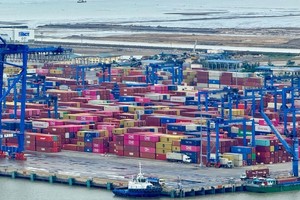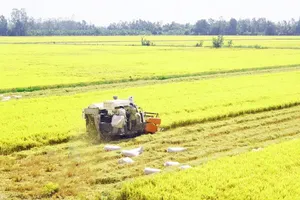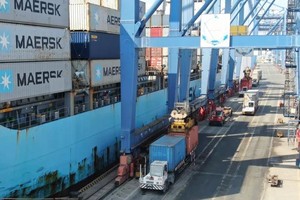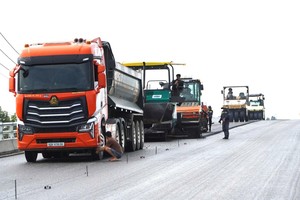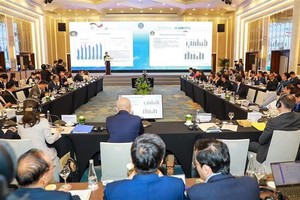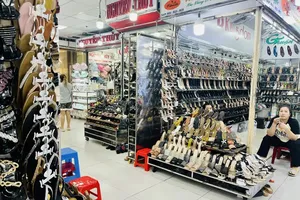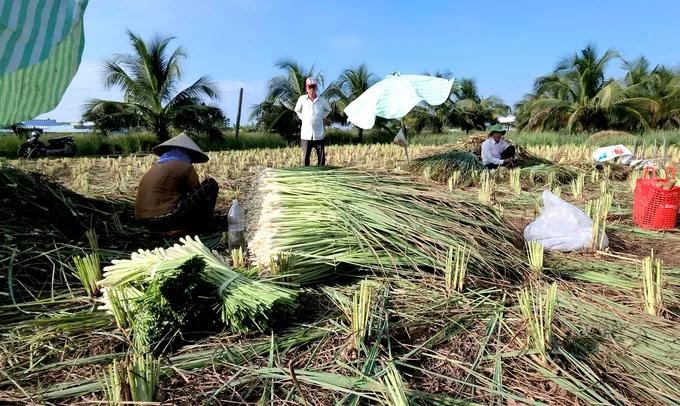
In the Mekong Delta, rice paddies are progressively being replaced by fruit orchards, short-term industrial crops, and aquaculture. This change in agricultural structure has, in its early stages, helped farmers and producers generate higher incomes.
Experts advised that to mitigate risks and negative impacts, localities, particularly farmers, should align their production with the market-oriented planning and guidance provided by relevant authorities.
Reducing rice land, increasing area for fruit trees
Farmer Le Van Tao in the Mekong Delta Province of Long An's Tan Thanh District who owns lush 3-hectare green-skinned grapefruit orchard shared that this is its second harvest. The majority of his grapefruits are pre-ordered for export to the Netherlands, with the remainder already reserved by local traders.
He revealed that last year, after expenses, he earned over VND200 million per hectare, noting that this profit is three times higher than rice cultivation. He plans to convert an additional two hectares of rice land to cultivate grapefruit and Thai jackfruit.
Across the Mekong Delta, farmers are similarly transforming thousands of hectares of less productive rice land into orchards for durian, dragon fruit, lemongrass, seedless lemon, and melon, as well as aquaculture. Notably, Hau Giang Province alone converted 14,980 hectares of rice land to fruit trees in 2024.
According to the Department of Agriculture and Environment in Hau Giang Province, production value has risen 2 to 5 times compared to pre-conversion levels. Deputy Director Tran Thai Nghiem of the Department of Agriculture and Environment in Can Tho City noted that the fruit tree cultivation area has been steadily expanding, with the sector’s value growing annually and significantly contributing to agriculture.
Elsewhere in Long An Province, Director Vo Minh Thanh of the Department of Agriculture and Environmen reported that from 2022 to 2024, over 1,020 hectares of land previously used for rice and other low-yield crops were converted to fruit trees, with 840 hectares in the Dong Thap Muoi region. Based on these results, Long An targets expanding fruit tree cultivation to over 5,700 hectares by 2025 and 10,000 hectares by 2030, having already achieved about 50 percent of the plan.
Meanwhile, in Ca Mau province, hundreds of farmers have escaped poverty and become well-off thanks to converting rice fields to shrimp farming, or combining rice farming with giant freshwater prawn farming.
Farmer Nguyen Viet Tuan in Khanh Thuan Commune in U Minh District of Ca Mau Province explained that insufficient investment in irrigation infrastructure and severe salinity intrusion made cultivating one or two rice crops per year unprofitable. Therefore, he invested in a rice-shrimp farming model in 2021 and his profits increased by 1.5 to 2 times compared to just growing rice. Thanks to that, his family's livelihood has significantly improved.
In line with strategic planning, Ca Mau Province is seeing a gradual reduction in its rice cultivation area. For instance, in Tran Van Thoi District, rice land measured over 35,388 hectares in 2020, with a target reduction to 32,122 hectares by 2030. Similarly, U Minh District's rice land, which was 25,463 hectares in 2020, is planned to decrease to 22,080 hectares by 2030.
Crop production must follow responsible agencies' plan
The shift from rice cultivation to fruit trees and aquaculture in the Mekong Delta has yielded significant economic benefits. However, successful conversion is not guaranteed everywhere or at all times if farmers fail to adhere to proper planning of planting areas, production guidance, and market alignment as directed by relevant authorities.
Chairman Pham Tung Chinh of the People's Committee of Thanh Hoa District of Long An Province said that the locality has planned over 560 hectares for seedless lemons and approximately 400 hectares for other fruit trees. Despite considerable efforts, Long An’s fruit trees struggle to compete in export markets due to high prices and quality standards that fall short of expectations.
This is largely because farmers face challenges in adopting clean farming practices and maintaining consistency. To address this, local authorities will collaborate with specialized agencies to enhance technical guidance, leverage information technology to connect farmers with markets, and promote their products effectively.
Echoing Chairman Pham Tung Chinh’s perspective, Deputy Director of the Hau Giang Province Department of Agriculture and Environment emphasized that farmers must fully comply with relevant regulations during crop conversion. This includes adhering to the authorities’ guidelines on planting and production area planning to prevent oversupply. Additionally, the cultivation, care, harvesting, and processing stages must ensure consistent product quality and stable output.
According to the Ministry of Agriculture and Environment, alongside the decrease in rice cultivation area, the fruit tree area in the Mekong Delta has increased very rapidly over the past 10 years. Currently, the Mekong Delta has over 400,000 hectares of fruit trees, an increase of nearly 36.6 percent in area and 66.2 percent in output compared to 2013.



